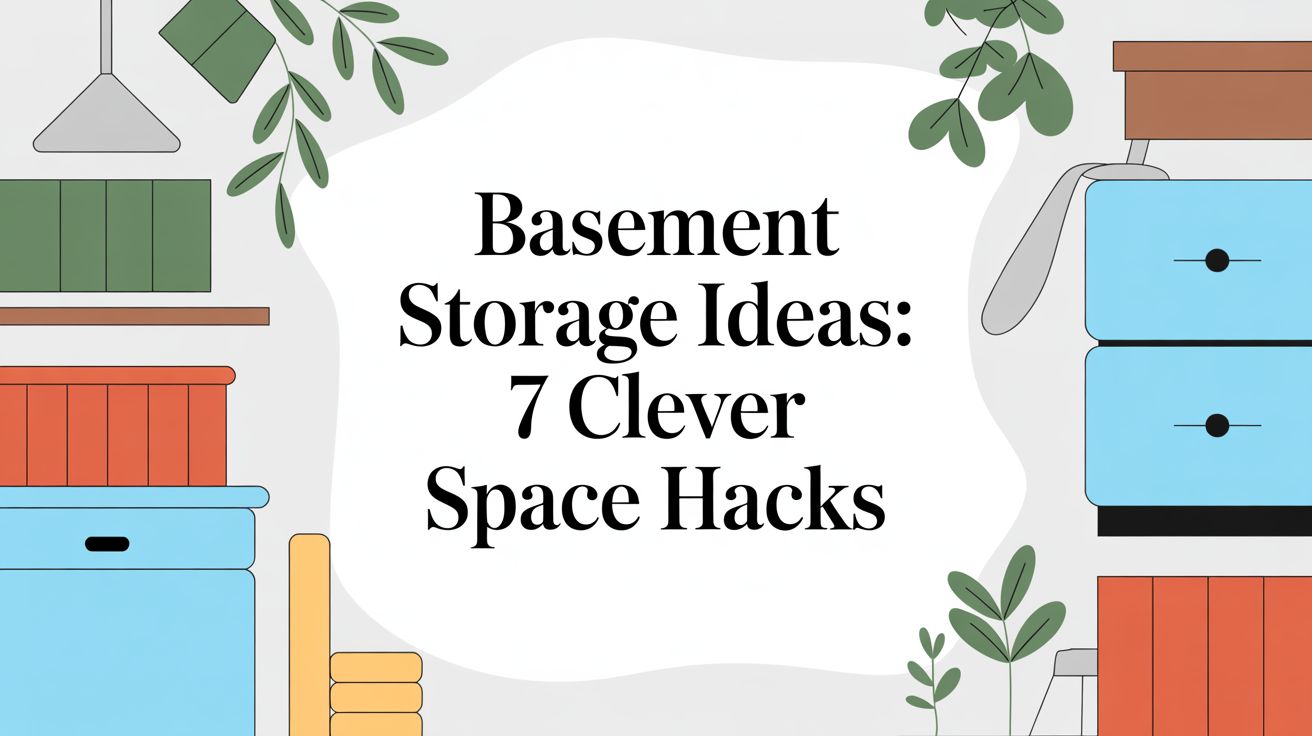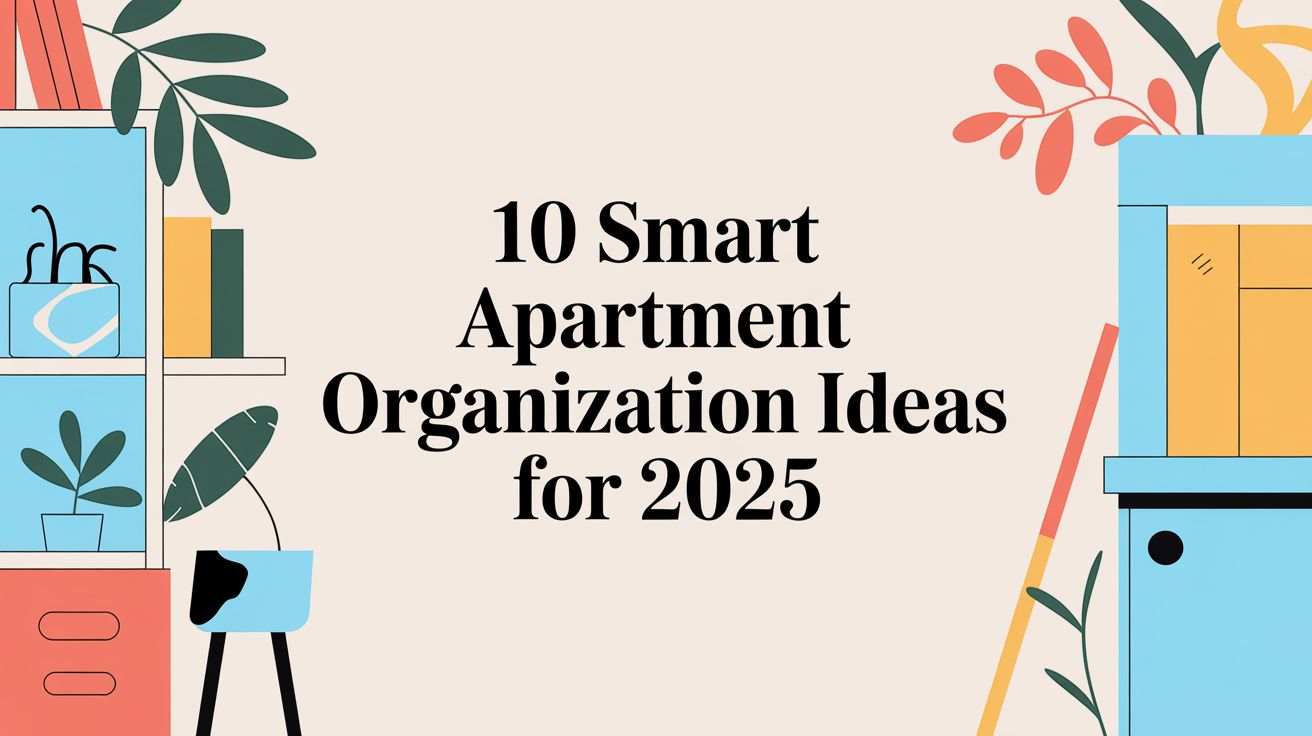That feeling of being buried under a mountain of paperwork? It’s universal. But getting control isn't about creating some complex, color-coded system from day one. It's about a quick, decisive win that clears the mental and physical clutter, giving you the momentum to build a lasting system.
Forget the overwhelm. We're going to start with a single, powerful step.
Your Action Plan for Immediate Document Control
The goal right now is simple: achieve a tangible victory that clears the path for more detailed organization later. This isn't about perfection; it's about progress. This approach is designed to reduce the initial paralysis that stops so many of us from even starting.
This infographic breaks down the process into its simplest form.
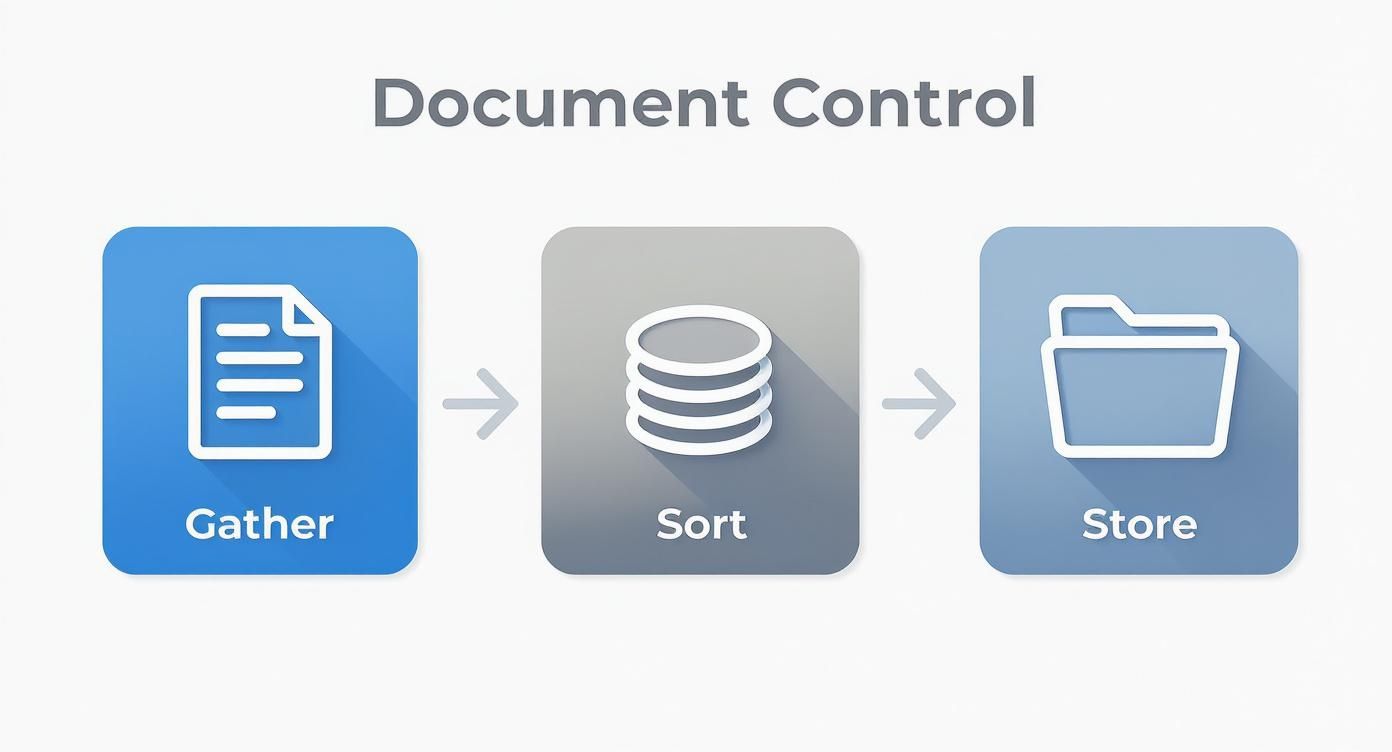
The real magic here is its simplicity. By focusing only on gathering and a quick sort, you sidestep decision fatigue and can make real, visible progress in less than an hour.
Start with the Three-Pile Method
Your mission, should you choose to accept it, is to touch every single piece of paper once and decide its fate. No second-guessing. Grab three boxes, laundry baskets, or just clear some floor space and label your zones: Keep, Shred, and Digitize.
- Keep: This pile is for the irreplaceable originals. Think birth certificates, Social Security cards, property deeds, passports, and car titles. The stuff you absolutely cannot lose.
- Shred: This is for anything with personal information that you no longer need to hold onto. Old bank statements, expired credit card offers, and utility bills from three years ago all go here. Don't just toss them; protect your identity.
- Digitize: Here's where you put documents you need for reference but don't need the physical copy clogging up your files. Receipts for minor purchases, old pay stubs, or appliance manuals fit perfectly here.
This quick sort does more than just tidy up. It's the first step in creating a full inventory of your life's most essential paperwork. Getting a clear view of your documents is also a perfect foundation for building a complete home inventory checklist.
Even in our digital world, physical documents are far from obsolete. Research shows that around 68% of households still hang on to paper files for their most critical records. In fact, 54% of households now use a hybrid approach, smartly combining physical files with digital backups for the best of both worlds (security and accessibility). You can find more great tips on organizing paper files over at the Ironclad Family blog.
Building a Filing System That Actually Works
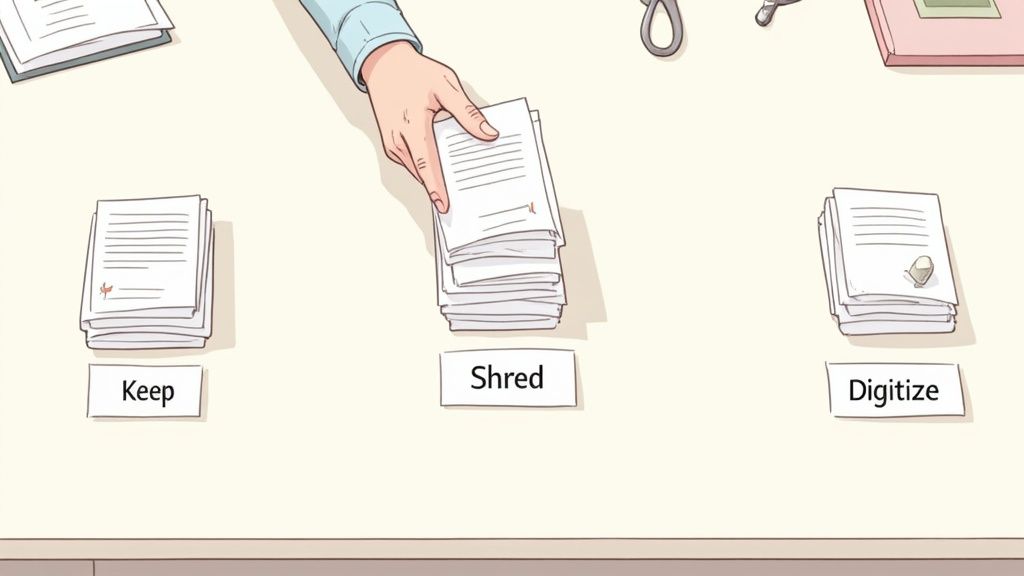
So you've wrestled that mountain of paper into a manageable pile. Great. Now comes the crucial part: building a structure that keeps the chaos from creeping back in.
A good filing system isn't just about stashing papers out of sight. It’s about being able to pull out exactly what you need in seconds, whether it’s a car title from five years ago or this month’s utility bill. The secret is to build a system that mirrors how your life is actually structured, not some rigid, alphabetical library list.
The most intuitive way to do this is by organizing by life categories. Think of these as the main departments of your household. When you start thinking this way, you'll find most of your documents naturally fall into just a few key areas.
This approach immediately solves the biggest filing headache: figuring out where something goes. When that annual property tax bill shows up, you instinctively know it belongs under "Household," not lost in a sea of folders under the letter "P."
Designing Your Core Categories
Let's start by creating a main folder for each of your primary life areas. While your exact setup will be unique to you, most households can build a rock-solid foundation with just four core categories. From there, you can add subcategories to make finding things even faster.
Here's a battle-tested setup that works for almost everyone:
- Financial: This is the hub for everything money-related. We're talking bank statements, credit card agreements, loan documents, tax returns, and investment records.
- Medical: All your family's health paperwork lives here. Think insurance policies, explanation of benefits (EOB) statements, prescription info, and medical histories for each person.
- Household: Consider this the operations manual for your home and major assets. It’s the spot for your mortgage or lease, utility bills, home repair receipts, and vehicle titles and maintenance records.
- Personal: This is for the irreplaceable stuff, which are your vital records and identity documents. It’s the secure home for birth certificates, Social Security cards, marriage licenses, passports, and wills.
Your system has to make sense to you. If you'd rather have a dedicated "Vehicle" folder with the loan, title, and repair receipts all in one place, do it. Don't split them between "Financial" and "Household" just because a guide told you to. Customization is what makes a system stick.
Once you’ve got those main categories down, the real power comes from drilling down into subcategories.
For example, inside that "Medical" folder, you might have separate files for each family member. Within your "Household" folder, you could have sub-folders for "Appliance Manuals," "Home Repair Receipts," and "Utility Bills." This extra layer of detail is what stops you from having to rifle through a thick stack of unrelated papers just to find one receipt.
Making It Visual and Functional
Now, let’s add the finishing touches that make the system truly effortless to use.
Color-coding is more than just making things look pretty; it's a powerful brain hack. Assigning a distinct color to each main category (say, green for Financial, blue for Medical) means you can grab the right folder without even reading the label. Your brain just knows "green means money stuff."
Finally, the most important habit you can build is creating a 'To-File' inbox. This isn’t complicated; it can be a simple wire tray on your desk or even just one designated folder. When mail comes in or you get a receipt, it immediately goes in the tray. No more piles on the counter.
Then, once a week, you spend 15 minutes processing everything in that inbox. You sort, file, and shred in one quick batch. This single habit is the key to preventing paper clutter from ever taking over your home again.
Choosing the Right Physical Document Storage
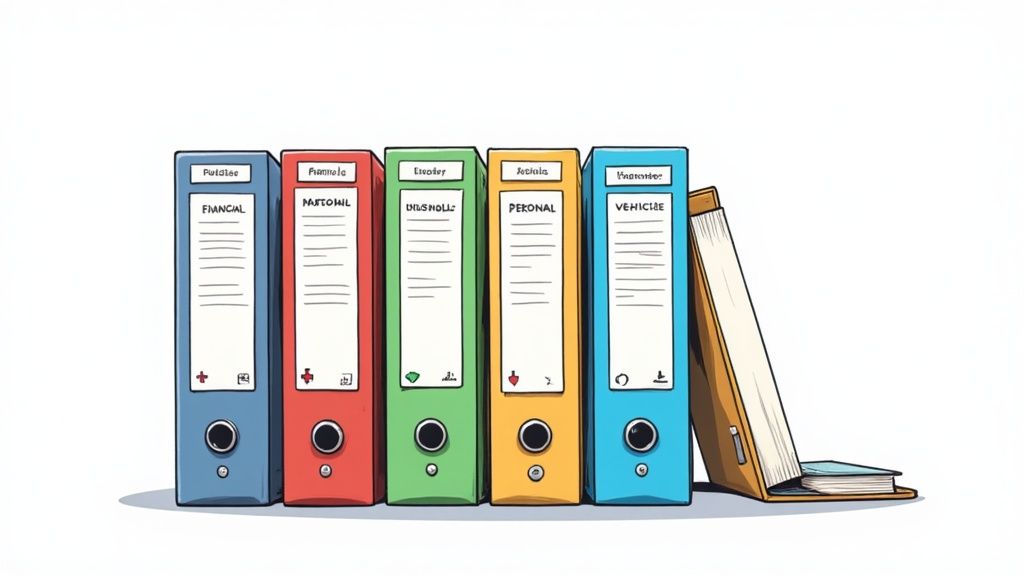
Alright, you’ve sorted, categorized, and tamed the paper beast. Now it's time to give those carefully organized files a proper home, one that’s a significant upgrade from a dusty cardboard box in the attic.
Choosing the right physical storage is a balancing act. It’s all about matching the right level of protection to the right documents. You wouldn't lock your weekly grocery receipts in a bank vault, but you also wouldn't leave your passport sitting on the kitchen counter. The goal is to build a smart, multi-layered storage strategy that fits your life.
Everyday Access Versus Long-Term Security
First things first: split your documents into two piles. The first pile is for papers you need to grab regularly, and the second is for the "break glass in case of emergency" stuff. This one decision will guide everything else, keeping your most critical papers safe from the chaos of daily life.
For your "active" files, like current bills, recent pay stubs, or papers for a project you're working on, you want simple and accessible.
- Portable File Boxes: These are fantastic. You can keep your core categories tidy and grab the whole box when it's time to pay bills or do your taxes. They slide easily into a home office closet or onto a shelf.
- Filing Cabinets: If you've got the space, even a small two-drawer cabinet provides a more permanent, structured home. It keeps everything flat, protected from dust, and neatly contained.
For your truly irreplaceable "archive" documents, security becomes the absolute priority. These are the papers that would cause a major headache, or even heartache, if they were lost to a fire, flood, or theft.
Fortifying Your Most Vital Records
When it comes to protecting birth certificates, Social Security cards, property deeds, and wills, it's time to bring in the heavy-duty hardware.
A fireproof and waterproof document safe is non-negotiable for these critical items. Don't just grab any metal box; look for one with a UL (Underwriters Laboratories) rating. This certification guarantees it can survive specific conditions, like 30 minutes of protection at 1550°F, which is often enough to get through a typical house fire.
People are definitely wising up to this. Consumer search trends for things like fireproof locking portable boxes spike every January and August. It's clear that these organizers are valued for both daily use and emergency prep, with about 58% of general users and 20% of homeowners finding them essential. You can dig into the data yourself by exploring these insights on document organizer popularity.
Think in terms of "a safe within a safe." Just because something is inside your house doesn't mean it's truly secure. Stash your fireproof box in a smart, discreet location, like the bottom of a hall closet or under a bed. Avoid the obvious places, like the master bedroom closet, which is usually the first place a burglar looks.
Finally, for the absolute highest level of protection, nothing beats a safe deposit box at a bank. This is the ultimate offsite solution for things you rarely need to touch but absolutely cannot afford to lose, such as original car titles, stock certificates, or irreplaceable family heirlooms. It gives you professional-grade security against just about any disaster you can imagine, delivering true peace of mind.
Creating a Smart and Secure Digital Archive
Having a rock-solid physical filing system is a great start, but pairing it with a digital counterpart is what truly prepares you for anything. Think of it as your ultimate safety net. A digital archive gives you immediate access to your documents from anywhere and serves as a critical offsite backup if a fire, flood, or theft ever hits home.
The idea of scanning everything can feel like a massive project, but you can forget about those bulky, expensive office scanners. High-quality mobile scanning apps on your smartphone can now capture crisp, clear PDFs in seconds. What used to be a chore is now a quick, surprisingly satisfying task.
Mirroring Your Physical System Digitally
The secret to a digital system you’ll actually stick with is familiarity. Don't reinvent the wheel. Instead, simply replicate the exact folder structure you already built for your physical files.
If you created a main "Financial" folder with subfolders for "Taxes" and "Bank Statements," do the exact same thing on your computer or cloud drive. This one-to-one mirroring makes the whole system intuitive. You’ll instinctively know where to find a digital document because it lives in the same logical place as its paper twin, dramatically cutting down on frustrating search time.
A Naming Convention That Works Like a Search Engine
Once your folders are set up, the next step is a consistent file naming convention. This small habit pays off big time. A folder full of files named scan_2024.pdf or img_1452.jpg isn't an archive; it's a digital junk drawer.
Instead, adopt a simple but incredibly powerful formula for every file you save:
YYYY-MM-DD_Document-Type_Recipient.pdf
Let's see it in action. A car insurance statement from Geico dated June 15, 2024, becomes:
2024-06-15_Car-Insurance-Statement_Geico.pdf
This format is brilliant for two reasons. First, it automatically sorts all your files chronologically, putting the most recent documents right at the top. Second, it makes every single file instantly searchable. Just typing "Geico" or "Car Insurance" into your computer’s search bar will pull it up immediately.
Choosing Secure and Reliable Cloud Storage
The final piece of your digital archive is deciding where it will live. Storing files only on your computer's local hard drive is a gamble, as one hardware failure could wipe out everything. This is where secure cloud storage becomes non-negotiable.
When you're picking a service, don't compromise on these two features:
- End-to-End Encryption: This ensures your documents are scrambled and unreadable to anyone but you, both while they're being uploaded and while they're sitting on the service's servers.
- Multi-Factor Authentication (MFA): This adds a crucial security checkpoint, requiring a second form of verification (like a code sent to your phone) before anyone can access your account.
Services like Dropbox, Google Drive, and Evernote all offer robust security features and make it simple to access your files from any device. This isn't just a niche trend; the U.S. document management services industry has grown into an estimated $8.7 billion market. You can read more about the growth of the document management market and why so many people are making this shift.
A well-organized digital archive can also connect seamlessly with other household management tools. For example, once you scan an appliance manual, why not link it directly to that item’s entry in your digital inventory? This is where using dedicated home inventory software can create a powerful, interconnected system for managing everything you own. Imagine not only knowing where an item is but having its receipt, manual, and warranty info available with a single click.
Keeping Your System From Falling Apart

Let’s be honest: creating an organization system is the fun part. The real test is keeping it alive. Without a little upkeep, even the most perfect setup will slowly crumble back into a chaotic pile of paper.
But maintenance doesn't have to be a huge, dreaded project. The goal is to weave it into the fabric of your weekly routine. Instead of a massive annual clean-out, think of it as a series of small, almost invisible habits that keep the paper monster at bay for good.
The 15-Minute Weekly Triage
This is the single most important habit you can build. Set aside a non-negotiable block of time each week to clear out your "To-File" inbox. It doesn't need to be long; 15-20 minutes is almost always enough to process a week's worth of mail and other papers.
- Pick a consistent time. Sunday evening works great as a reset for the week ahead.
- Handle every piece of paper once. Your only job is to decide: does this get scanned, filed, shredded, or acted on?
- Take action immediately. If a bill needs to be paid, pay it. If a permission slip needs a signature, sign it. Don't put it back in the pile "for later."
- Scan and file on the spot. Use your phone to scan anything going digital, then put the physical copy right where it belongs.
This simple weekly ritual is the secret sauce. It stops the small drips from turning into an overwhelming flood, keeping your desk (and your mind) clear.
The Annual Check-Up
While your weekly triage handles the incoming flow, an annual audit keeps the entire system lean and relevant. Once a year, carve out an hour or two to go through your files. This is your chance to shred what you no longer need and rethink what you're storing.
This is also the perfect moment to move documents from your active files into long-term archival storage. This keeps your everyday filing cabinet or fireproof box from getting bloated with old tax returns or ancient mortgage statements you rarely need to see.
For more ideas on keeping your entire home in order, these home organization hacks are a fantastic resource that goes hand-in-hand with a streamlined paper system.
Evolving With Life's Big Moments
Your filing system isn't a static museum exhibit; it has to grow and change with you. Think of major life events as natural checkpoints to update and expand your document library.
- Buying a Home? Create a new "Property" category with subfolders for the deed, mortgage papers, and inspection reports.
- Welcoming a Child? Start a brand new personal file for the baby, ready for their birth certificate and Social Security card.
- Getting Married? Add the marriage license to your vital records and file any documents related to name changes.
When these things happen, take a few minutes to integrate the new paperwork properly. It's a proactive step that ensures your system always reflects your current life, keeping it genuinely useful for years to come.
Common Questions About Organizing Documents
Even with a perfect system mapped out, you’re bound to hit a few specific snags when you start sorting through years of paperwork. I see it all the time. Getting the details right on these common questions is what separates a system that actually works from one that just creates a different kind of mess.
So, let's tackle the most frequent challenges people run into. Think of this as your quick-start guide to fine-tuning your approach and getting over those little hurdles that can stop you in your tracks.
What Documents Must I Keep as Originals?
Scanning is a game-changer for day-to-day access and creating backups, but you can't just shred everything. Certain documents are legally worthless as a digital copy and you absolutely must keep the physical original.
These are almost always papers with a raised seal, a "wet" signature, or a specific legal status that a PDF simply can't replicate.
- Vital Records: This is non-negotiable. We're talking birth certificates, death certificates, and marriage licenses.
- Property and Ownership: The original deed to your house, titles for your cars, and any physical stock or bond certificates.
- Legal and Estate Documents: Your last will and testament, power of attorney forms, and any trust documents need to be kept in their originally signed form.
For these truly irreplaceable documents, the best practice is simple: scan a copy for your digital files, but lock the originals away in a high-quality fireproof safe at home or in a bank's safe deposit box. Don't take chances here.
How Long Should I Keep Other Documents?
Okay, for everything else, how long is long enough? The answer depends on the document, but there are some solid rules of thumb that will keep you covered without turning your home into a paper museum.
A good baseline is to hold onto anything tax-related for at least seven years. That timeframe covers the vast majority of IRS audit windows and gives you a safe buffer.
For other common household papers, here's what I recommend:
- Pay Stubs: Keep them for one full year. You'll want them on hand to double-check against your annual W-2 form. Once that's done and everything matches up, they can be shredded.
- Bank Statements: One year is usually plenty, unless you need a specific statement to prove a tax-deductible purchase.
- Credit Card Statements: I find three months is often enough. The big exception? If a statement shows proof of purchase for a major item like an appliance, hang onto it until that item's warranty expires.
- Home Improvement Records: Keep every single receipt and contract for as long as you own your home. These records can help increase your home's cost basis when you eventually sell, potentially saving you a significant amount on taxes.
A smart system makes it obvious when it's time to purge, so you can find what you need in seconds without getting buried in paper you should have tossed years ago.
Ready to create a truly smart home? With Vorby, you can link your newly scanned documents directly to your physical items. Scan your TV's receipt and link it to the TV in your inventory, complete with its manual and warranty information. Find everything you own, and everything about it, in seconds. Start your free trial at https://vorby.com and connect your physical and digital worlds.

